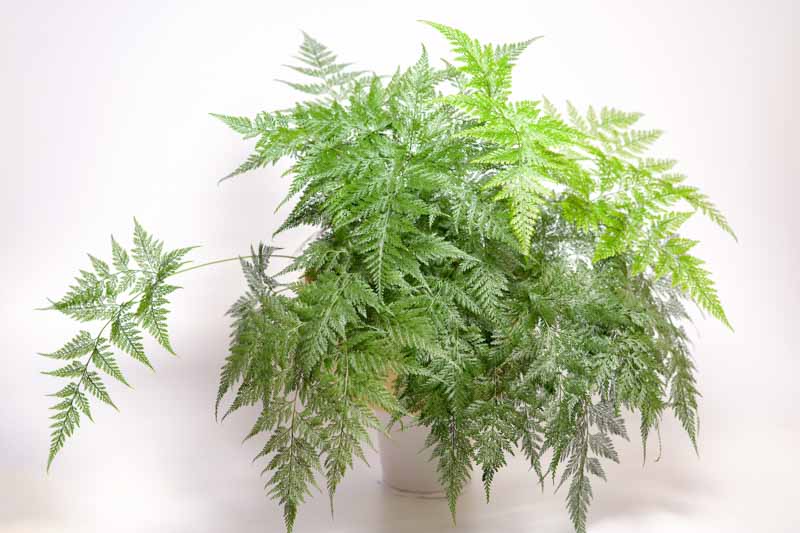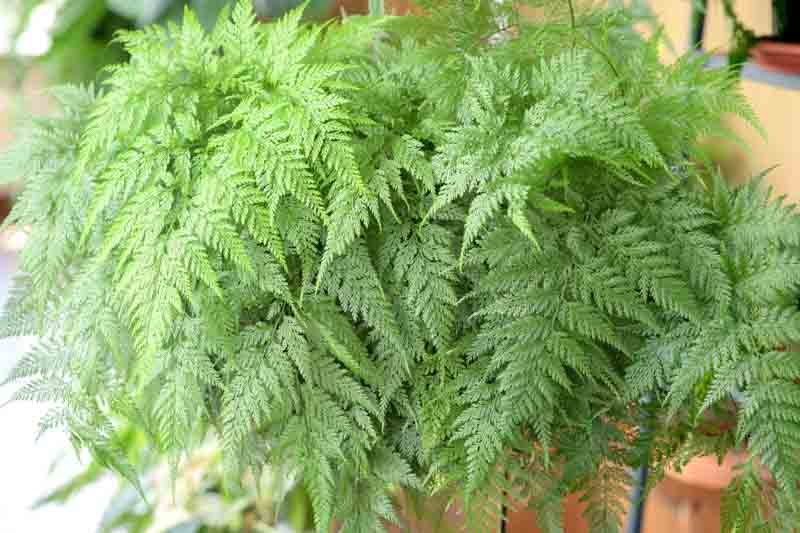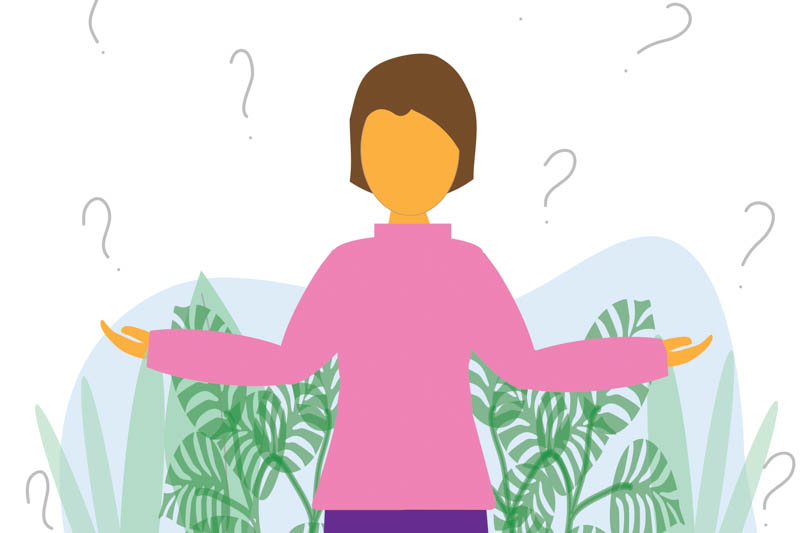Dainty Rabbits-Foot Fern, Fijian Hares' Foot Fern, Lacy Hare's Foot, Lacy Paw, Rabbits Foot Fern, Rabbit's Foot Fern, Davallia solida var. fejeensis
Davallia fejeensis, commonly known as the Rabbit’s Foot Fern due to its distinctive, furry rhizomes, is a perennial, epiphytic fern that adds an exotic touch to indoor and shaded garden spaces.
Rabbit’s Foot Fern is renowned for its soft, finely divided fronds that emerge from peculiar, brown, hairy rhizomes. These rhizomes often sprawl over the pot, resembling a rabbit’s foot, which gives the plant its common name. The foliage is delicate, with a lush, green appearance that can add a touch of ferny foliage to any setting.
Native: This fern is native to the Fiji Islands, along with other tropical regions in the South Pacific. Its natural habitat includes moist, forested areas where it grows as an epiphyte, attaching to tree trunks and branches. It belongs to the Davalliaceae family.
Plant Type and Habit: As an epiphytic, evergreen fern, Rabbit’s Foot Fern grows by anchoring its thick, hairy-scaled rhizomes onto other plants or substrates without harming them. It has a clumping habit with fronds that gracefully arch outward.
Size: This tropical fern typically grows 1-3 feet tall (30-90 cm) and 1-4 feet wide (30-120 cm). Its rhizomes can extend beyond the pot, adding to its spread and visual interest.
Flowers: Being a fern, Rabbit’s Foot Fern does not produce flowers. Ferns reproduce through spores, which are found on the undersides of their fronds.
Foliage: The fronds are tripinnate, meaning they are divided three times, and have a delicate, lace-like appearance. They are bright, glossy green, contributing to the plant’s overall lush look.
Hardiness: Rabbit’s Foot Fern is hardy in USDA zones 10-12 when planted outdoors. It is more commonly grown as a houseplant in cooler climates due to its temperature sensitivity.
Uses: Davallia fejeensis is primarily used as an ornamental plant. It’s perfect for hanging baskets, where its unique rhizomes and lush fronds can be displayed to their full advantage. It’s also suitable for terrariums and as a tabletop plant.
Toxicity: The Rabbit’s Foot Fern is non-toxic to pets and humans, making it a safe choice for households with children and animals.
Deer and Rabbits: This fern is generally not bothered by deer and rabbits.
Invasiveness: Davallia fejeensis is not considered invasive. When grown outside its native habitat, it is primarily kept as a contained houseplant or in controlled garden conditions.
Benefits: Besides its high ornamental value, the Rabbit’s Foot Fern helps purify indoor air. Its unique appearance and growth habit make it a conversation starter and a delightful addition to any plant collection.

Growing and caring for a Rabbit’s Foot Fern involves creating a nurturing environment miming its natural tropical habitat. Here’s how to ensure your Rabbit’s Foot Fern thrives, whether you’re cultivating it indoors or outdoors:
Light: Rabbit’s Foot Fern prefers bright, indirect light. Avoid direct sunlight, which can scorch its delicate fronds. A north or east-facing window is ideal.
Soil: Use a well-draining, peat-based potting mix. Ensure the pot has good drainage to prevent root rot.
Watering: Keep the soil consistently moist but not waterlogged. Water when the top inch of soil feels dry to the touch. Use lukewarm water to avoid shocking the plant.
Humidity: This fern loves high humidity. Increase humidity by placing the pot on a tray filled with pebbles and water, misting the fern regularly, or using a humidifier.
Temperature: Maintain indoor temperatures between 65-75°F (18-24°C) during the day and not below 55°F (13°C) at night. Avoid drafts and sudden temperature changes.
Feeding: Feed with a diluted, balanced liquid fertilizer once a month during the growing season (spring through summer).
Location: Outdoors, Rabbit’s Foot Fern thrives in shaded areas with indirect sunlight. It’s perfect for shaded gardens or as an understory plant.
Watering & Humidity: Ensure the fern is kept moist, especially in dry conditions. Outdoor humidity is generally suitable, but additional misting may be beneficial in dry climates.
Soil: Plant in rich, well-draining soil with plenty of organic matter. If soil drainage is a concern, consider raising the planting area or using a suitable container.
Temperature: Rabbit’s Foot Fern can be grown outdoors year-round in USDA zones 10-12. In cooler zones, it should be brought indoors before the first frost.
Repotting: Repot in the spring every 2-3 years or when the rhizomes outgrow the pot. The rhizomes can be gently divided during repotting to propagate new plants.
Pruning: Trim away any brown or damaged fronds to keep the plant healthy and attractive. This can be done at any time of year.
Rhizome Care: The characteristic “rabbit’s foot” rhizomes should sit on top of the soil. They are not only intriguing to look at but also store moisture, helping the fern tolerate slight drying between waterings.

Propagating a Rabbit’s Foot Fern is a straightforward process primarily involving division.
Timing: The best time to propagate Rabbit’s Foot Fern is in the spring or early summer when the plant is in its active growth phase.
Remove the Fern: Gently remove the fern from its pot, taking care not to damage the rhizomes and roots. Shake off excess soil to better view the rhizome structure.
Divide the Rhizomes: Look for natural divisions in the rhizome cluster. Using your hands or a clean, sharp knife, separate the rhizomes into sections, ensuring each section has at least one or two fronds attached.
Potting the Divisions: Plant each rhizome section in its own pot, laying the rhizome on the surface of the potting mix. The fronds should be upright, and the rhizome should sit on top of the soil, as burying it can cause rot. Lightly press the soil around the base of the fronds to secure the plant.
Aftercare: Water each new plant lightly to settle the soil around the roots. Place the pots in a location that receives bright, indirect light and maintain high humidity around the plants, using a pebble tray or humidifier if indoors.
Rabbit’s Foot Fern is relatively easy to care for, but like all plants, it can encounter pests, diseases, and common issues.
Spider mites: Tiny spider-like pests that thrive in dry conditions, causing yellow or brown spots on leaves and fine webbing. Increase humidity and wash the fern under lukewarm water, or use insecticidal soap as a treatment.
Mealybugs: Small, cottony pests that suck sap from the plant, weakening it. Remove them manually with a cotton swab dipped in rubbing alcohol, or treat with neem oil.
Scale insects: Hard-shelled pests that attach to the stems and undersides of leaves, draining the plant’s sap. Scrape them off gently or treat with horticultural oil.
Root rot: Overwatering or poor drainage can lead to root rot, characterized by mushy roots and wilted, yellowing leaves. Ensure proper drainage and allow the top inch of soil to dry between waterings.
Fungal Infections: Overly humid conditions without adequate air circulation can encourage fungal diseases like leaf spot. Improve air circulation, reduce overhead watering, and remove affected foliage.
Brown Leaf Tips: Often a result of low humidity or salt buildup in the soil. Increase humidity around the plant and flush the soil with water periodically to remove excess salts.
Yellowing Leaves: Can be caused by overwatering, underwatering, or nutrient deficiencies. Adjust your watering routine to ensure the soil is consistently moist but not waterlogged, and consider repotting if the issue persists.
Slow Growth: Insufficient light or nutrients can slow down growth. Ensure the fern is receiving bright, indirect light and feed with a balanced, diluted fertilizer during the growing season.

Rabbit’s Foot Fern prefers bright, indirect sunlight. Direct exposure, especially during the hottest parts of the day, can scorch its delicate fronds. A spot that receives filtered light through a sheer curtain is ideal.
Yes, Rabbit’s Foot Fern can tolerate low light conditions, making it a versatile houseplant. However, too little light may slow its growth and reduce the lushness of its foliage. It performs best in moderate to brightly lit environments.
Rabbit’s Foot Ferns are relatively easy to care for, especially for those familiar with the basic needs of ferns. Their care revolves around maintaining high humidity, ensuring the soil stays consistently moist but not waterlogged, and avoiding direct sunlight. Their forgiving nature makes them suitable for beginners willing to meet their humidity requirements.
Yes, Rabbit’s Foot Ferns enjoy being misted. High humidity is crucial for their well-being, so regular misting can help replicate the moisture levels of their natural tropical habitat. In dry indoor environments, daily misting is beneficial, along with other methods to increase humidity, such as using a humidifier or placing the plant on a pebble tray with water.
The best container for a Rabbit’s Foot Fern is one that allows for good drainage to prevent waterlogged soil, which can lead to root rot. A pot made from porous material like terracotta can help manage moisture levels. Since the fern’s rhizomes grow and spread over the edge of the pot, choosing a slightly larger container that accommodates this growth without being too deep is ideal. Ensure the pot has drainage holes at the bottom.
| Hardiness |
10 - 12 |
|---|---|
| Plant Type | Houseplants, Ferns |
| Plant Family | Davalliaceae |
| Exposure | Partial Sun |
| Season of Interest |
Spring (Early, Mid, Late) Summer (Early, Mid, Late) Fall Winter |
| Height |
1' - 3' (30cm - 90cm) |
| Spread |
1' - 4' (30cm - 120cm) |
| Maintenance | Low |
| Water Needs | Average |
| Soil Type | Loam |
| Soil pH | Acid, Neutral |
| Soil Drainage | Moist but Well-Drained |
| Characteristics | Showy, Evergreen |
| Tolerance | Deer, Rabbit |
| Garden Uses | Hanging Baskets, Patio And Containers |
| Hardiness |
10 - 12 |
|---|---|
| Plant Type | Houseplants, Ferns |
| Plant Family | Davalliaceae |
| Exposure | Partial Sun |
| Season of Interest |
Spring (Early, Mid, Late) Summer (Early, Mid, Late) Fall Winter |
| Height |
1' - 3' (30cm - 90cm) |
| Spread |
1' - 4' (30cm - 120cm) |
| Maintenance | Low |
| Water Needs | Average |
| Soil Type | Loam |
| Soil pH | Acid, Neutral |
| Soil Drainage | Moist but Well-Drained |
| Characteristics | Showy, Evergreen |
| Tolerance | Deer, Rabbit |
| Garden Uses | Hanging Baskets, Patio And Containers |
How many Davallia fejeensis (Rabbit’s Foot Fern) do I need for my garden?
| Plant | Quantity | |
|---|---|---|
| Davallia fejeensis (Rabbit’s Foot Fern) | N/A | Buy Plants |
Create a membership account to save your garden designs and to view them on any device.
Becoming a contributing member of Gardenia is easy and can be done in just a few minutes. If you provide us with your name, email address and the payment of a modest $25 annual membership fee, you will become a full member, enabling you to design and save up to 25 of your garden design ideas.
Join now and start creating your dream garden!
Create a membership account to save your garden designs and to view them on any device.
Becoming a contributing member of Gardenia is easy and can be done in just a few minutes. If you provide us with your name, email address and the payment of a modest $25 annual membership fee, you will become a full member, enabling you to design and save up to 25 of your garden design ideas.
Join now and start creating your dream garden!